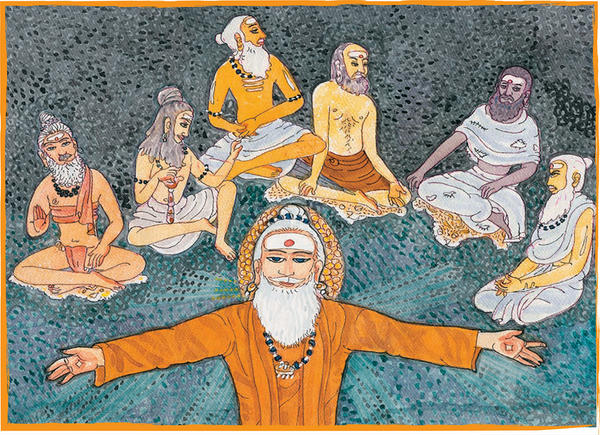36 What Is Our Heritage of Gurus?§
Gurudeva holds his arms wide to embrace the lineage of past satgurus: (from left to right) Maharishi Nandinatha, Tirumular, Rishi from the Himalayas, Kadaitswami, Chellappaswami and Yogaswami.§
S. RAJAM§
Since the beginning of time, the power, or shakti, of God Siva has been carried forth by enlightened beings, satgurus. That power is like a brilliant ray of spiritual energy. Many of these masters trained other great souls and passed on their power to them. As this happened again and again for thousands of years, many chains of gurus, called parampara, were formed. Our lineage is called the Kailasa Parampara. It means the lineage from Siva’s Himalayan mountain, Kailas. It began thousands of years ago. The first master that history records is Maharishi Nandinatha (ca 250 bce). He passed his power to Rishi Tirumular, a sage who wrote a yoga text called Tirumantiram. After him, over 150 rishis carried the shakti of Siva forward, their names lost to history. In the 19th century, a nameless Himalayan rishi of this lineage traveled to Bengaluru in South India. There he passed the thread of power to Kadaitswami (1804–1891) and sent him to Sri Lanka to strengthen Saivism there. Kadaitswami passed his power to Sage Chellappaswami (1840–1915). He, in turn, initiated Satguru Yogaswami (1872–1964). In 1949, Yogaswami ordained our Gurudeva, Sivaya Subramuniyaswami (1927–2001). Gurudeva brought Saivism to the West and established Kauai Aadheenam, his monastery, on the Hawaiian island of Kauai in 1970. In 2001 he initiated Bodhinatha Veylanswami as his successor. The power from all previous gurus and the blessings of the devas that assist them abide in the current preceptor.§
GURUDEVA: Hindu temples sustain Hinduism around the world. Scriptures keep us always reminded of the path we are on and the path we are supposed to be on, but only from the satguru can you get the spirit, the shakti, the sustaining spirit, to make it all come to life in you, to make the temple meaningful and to complement the scriptures with your own sight, your own third-eye sight.§

